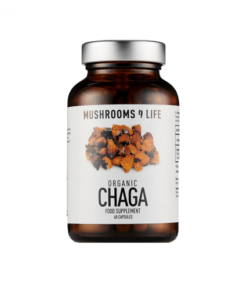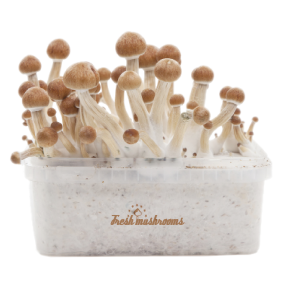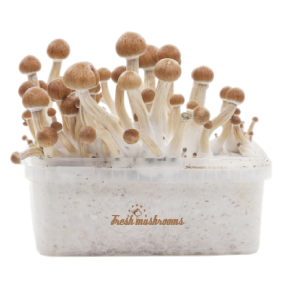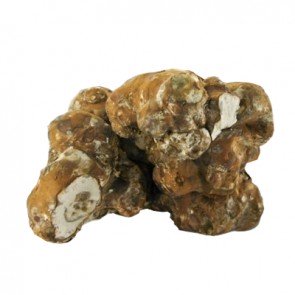Magic Mushroom Grow Kit Golden Teacher
$45.00
magic mushroom grow kit
It happened faster than seemed right. One day, the tiny gray pinheads of mushrooms were just beginning to emerge from a two-inch cut in a bag of sawdust; the next, they were huge, scalloped hand-like lobes. They looked practically in motion, like muscular forearms reaching out of a wormhole.
It was early summer and I was growing blue oyster mushrooms on my kitchen counter. It was more dramatic than I could have imagined.
It started out benignly enough. About two months into lockdown, the ecology of my Instagram feed began to shift away from sourdough bread and toward mushroom grow kits. These kits are blocks of compressed waste from sawmills, which have been implanted with the mycelium of wood-eating fungus. (Mycelium are the fine, hairlike tendrils that are the principal part of any fungus; mushrooms are merely the fruiting parts — similar to apples on a tree.)
ADVERTISEMENT
SKIP ADVERTISEMENT
The mycelium, delighted to find themselves nestled in a cocoon of their favorite food, grow threads, digesting sawdust as they go, probing for a bit of air and moisture, which they cannot find, because the blocks are encased in plastic bags.


That is where the fungal gardener comes in: If you cut an X in the plastic and spritz that X with water a few times a day, the mycelium will find their way to that spot, communicating across their many tendrils to coalesce into solid flesh, and will burst forth as mushrooms.
Sacks of sawdust filled my friends’ counters, each frothing over with bulbous lion’s mane or disgorging scaly oyster mushrooms. The kits for growing pink oysters, which emerge as a cascade of salmon shingles, were particularly photogenic.
I called two mushroom farms that had supplied the bulk of my friends’ kits and learned business was booming. “It’s been a very steep increase in sales,” said Matt McInnis, one of the founders of North Spore, in Portland, Maine, which was started in 2014 by three friends who went mushroom foraging together in college. Sales of introductory mushroom growing supplies had increased 400 percent during the pandemic over the previous spring, he said.
Smallhold, a farm in Brooklyn that had previously supplied restaurants with mushrooms and installed mini mushroom farms in commercial kitchens, also had a spike when it pivoted to at-home mushroom kits as restaurant orders dried up, the farm said. Customers tagged Smallhold in endless posts of sculptural mushroom clusters that emerged, somehow, nearly overnight.
ADVERTISEMENT
SKIP ADVERTISEMENT
“Mushrooms are mysterious and ephemeral,” Andrew Carter, 35, a founder of Smallhold, had warned me before I took my kits home. He said they were more like growing animals than plants, but not quite that either; after all, fungi are a kingdom of life all their own. “They may not look like anything for a while and then all of a sudden there’s mushrooms,” he said. “It’s unlike anything people have seen.”
Explore the World of Mushrooms
Rich in umami and known for their health properties, fungi are a kingdom of life all of their own.
- Chocolate: A new wave of confections are harnessing the ancient pairing of fungi and cacao (without the hallucinogenic effects).
- The Genius of Fungi: A vast fungal web braids together life on Earth. Merlin Sheldrake wants to help us see it.
- Carnivore Fungus: The oyster mushroom has earned a reputation for activities more sinister than you’d expect from a fungus found in fine dining: feeding on worms.
- Foraging: Hunting for mushrooms keeps your mind and body active, and allows you to immerse in nature. Here is to plan a foraging adventure on the West Coast.
Trendy Trash Monsters




Across Asia, mushrooms have long been prized, for food and flavor, medicinal and ritualistic purposes, and in poetry and prose. Rich mushroom foraging traditions have been passed down for centuries in several parts of Europe as well, where going to a forest on the weekend to pick mushrooms is still a common family outing. In France, virtually every town has its own mushroom expert, trained by the government.
Colonizers brought these traditions to the Americas, where Native American people had also been eating foraged mushrooms forever. In regions like Appalachia, wild mushroom hunting — particularly for morels — remains part of the rural foodways.
And while urbanites tending mushrooms in cramped apartment kitchens may seem a far leap from those traditions, their interest in fungi — along with the continuing rise of meat-shunning diets — is a small component of a global passion. Mushroom import and export is an enormous worldwide business, with the mushroom market expected to reach $86.6 billion by 2025, according to the market research company IMARC.
That passion may also have to do with new applications of mycelium, and novel research into its seeming world-saving potential.
ADVERTISEMENT
SKIP ADVERTISEMENT
Fungi thrive on waste and decay. They are, in essence, trash monsters, making value out of chaos. “Mushrooms are decomposers,” Mr. McInnis, 33, said. “If you provide them with an opportunity to consume something they will.”
And they’ll do it fast: Crops of mushrooms are known to emerge fully formed overnight, sometimes pushing up unthinkably heavy loads of earth and pavement in the process. No one yet knows how it is possible for a soft thing to heave so much.
Be the first to review “Magic Mushroom Grow Kit Golden Teacher” Cancel reply
Related products
Twenty Two K
Mushroom Supplements
Magic Mushroom Grow Kits
Magic Mushroom Grow Kit Amazon,Magic Mushroom Grow Kit Amazon
Jetty Extracts
Twenty Two K
Magic Mushroom Grow Kits
Twenty Two K
Magic Truffles











Reviews
There are no reviews yet.